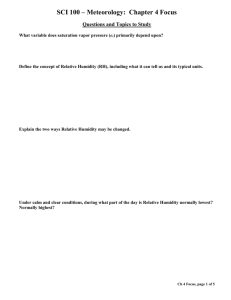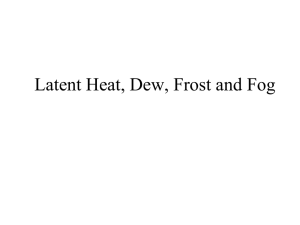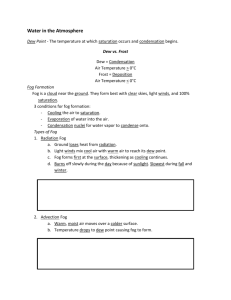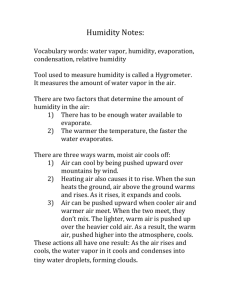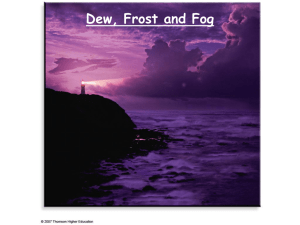PDS-Urban-definitions-19th
advertisement
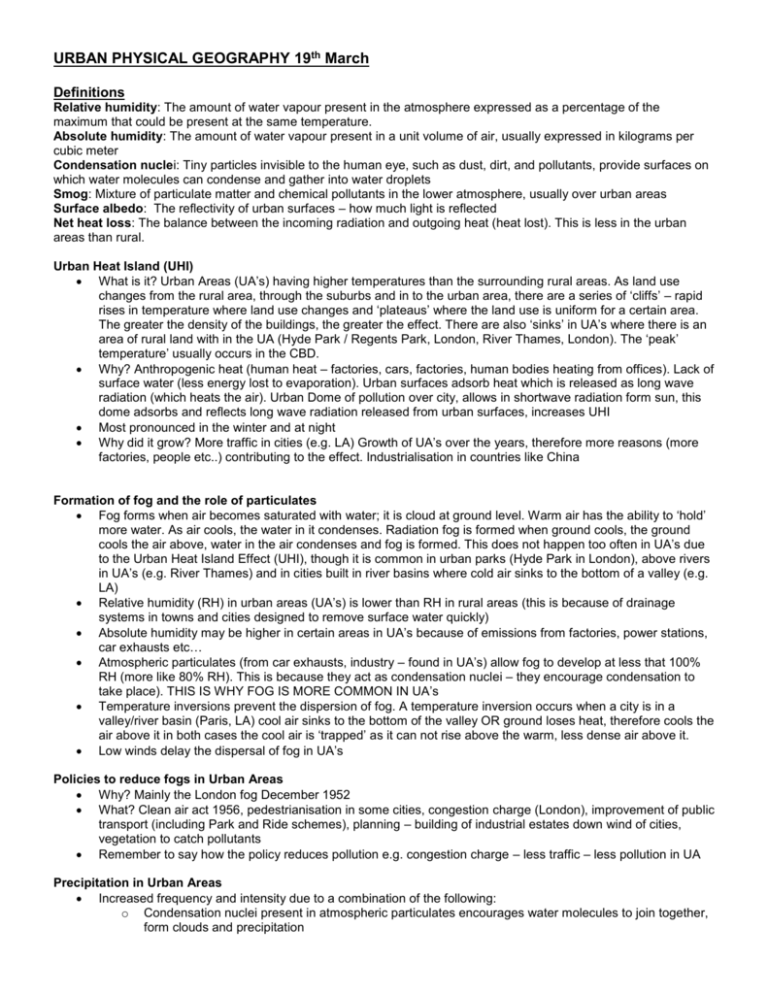
URBAN PHYSICAL GEOGRAPHY 19th March Definitions Relative humidity: The amount of water vapour present in the atmosphere expressed as a percentage of the maximum that could be present at the same temperature. Absolute humidity: The amount of water vapour present in a unit volume of air, usually expressed in kilograms per cubic meter Condensation nuclei: Tiny particles invisible to the human eye, such as dust, dirt, and pollutants, provide surfaces on which water molecules can condense and gather into water droplets Smog: Mixture of particulate matter and chemical pollutants in the lower atmosphere, usually over urban areas Surface albedo: The reflectivity of urban surfaces – how much light is reflected Net heat loss: The balance between the incoming radiation and outgoing heat (heat lost). This is less in the urban areas than rural. Urban Heat Island (UHI) What is it? Urban Areas (UA’s) having higher temperatures than the surrounding rural areas. As land use changes from the rural area, through the suburbs and in to the urban area, there are a series of ‘cliffs’ – rapid rises in temperature where land use changes and ‘plateaus’ where the land use is uniform for a certain area. The greater the density of the buildings, the greater the effect. There are also ‘sinks’ in UA’s where there is an area of rural land with in the UA (Hyde Park / Regents Park, London, River Thames, London). The ‘peak’ temperature’ usually occurs in the CBD. Why? Anthropogenic heat (human heat – factories, cars, factories, human bodies heating from offices). Lack of surface water (less energy lost to evaporation). Urban surfaces adsorb heat which is released as long wave radiation (which heats the air). Urban Dome of pollution over city, allows in shortwave radiation form sun, this dome adsorbs and reflects long wave radiation released from urban surfaces, increases UHI Most pronounced in the winter and at night Why did it grow? More traffic in cities (e.g. LA) Growth of UA’s over the years, therefore more reasons (more factories, people etc..) contributing to the effect. Industrialisation in countries like China Formation of fog and the role of particulates Fog forms when air becomes saturated with water; it is cloud at ground level. Warm air has the ability to ‘hold’ more water. As air cools, the water in it condenses. Radiation fog is formed when ground cools, the ground cools the air above, water in the air condenses and fog is formed. This does not happen too often in UA’s due to the Urban Heat Island Effect (UHI), though it is common in urban parks (Hyde Park in London), above rivers in UA’s (e.g. River Thames) and in cities built in river basins where cold air sinks to the bottom of a valley (e.g. LA) Relative humidity (RH) in urban areas (UA’s) is lower than RH in rural areas (this is because of drainage systems in towns and cities designed to remove surface water quickly) Absolute humidity may be higher in certain areas in UA’s because of emissions from factories, power stations, car exhausts etc… Atmospheric particulates (from car exhausts, industry – found in UA’s) allow fog to develop at less that 100% RH (more like 80% RH). This is because they act as condensation nuclei – they encourage condensation to take place). THIS IS WHY FOG IS MORE COMMON IN UA’s Temperature inversions prevent the dispersion of fog. A temperature inversion occurs when a city is in a valley/river basin (Paris, LA) cool air sinks to the bottom of the valley OR ground loses heat, therefore cools the air above it in both cases the cool air is ‘trapped’ as it can not rise above the warm, less dense air above it. Low winds delay the dispersal of fog in UA’s Policies to reduce fogs in Urban Areas Why? Mainly the London fog December 1952 What? Clean air act 1956, pedestrianisation in some cities, congestion charge (London), improvement of public transport (including Park and Ride schemes), planning – building of industrial estates down wind of cities, vegetation to catch pollutants Remember to say how the policy reduces pollution e.g. congestion charge – less traffic – less pollution in UA Precipitation in Urban Areas Increased frequency and intensity due to a combination of the following: o Condensation nuclei present in atmospheric particulates encourages water molecules to join together, form clouds and precipitation o o o The urban area is warmer, therefore air rises in the UA, the rising air cools, water in it condenses, and precipitation occurs (convectional uplift) Buildings force air up, air cannot move through buildings, therefore it is forced over the buildings, at height, the air cools, water in it condenses, and precipitation occurs large urban areas can slow down the passage of depressions by frictional drag, this means that rain cloud can stay over the urban area longer. Thunderstorms – Frequency and intensity Thunderstorms are more common in urban areas for 2 main reasons. The main one is that the UHI creates a localised area of low pressure (air is rising as it is warmer in the UHI) This draws in air from the surrounding area. As the air approaches the urban area it warms up. This warm air is then subject to convectional uplift (rising as it is warmer.) This uplift accelerates. The rate of cooling of the rising air is less than that of the surrounding air, making the temperature difference even greater. Large cumulonimbus clouds develop and storms occur. The whole thing is aided also by the presence of a greater number of hygroscopic nuclei in the form of particulate pollution. Wind speed and intensity Average wind speed in UA’s are reduced, due to friction between rough surface (of UA) and moving air. Some areas are completely sheltered from winds due to deflection (therefore average speed is reduced in UA’s despite the fact that there are still high speed gusts) Gusts and heavy turbulence are caused by differences in pressure. On the windward side of a building (the side facing the wind) there is over (high) pressure (air always moves from high to low pressure). The pressure on the building increases with height. This causes a downwards flow of air down the front side of a building, which becomes a vortex (revolving air) when it hits the ground. This effect increases if there is a small building to the windward (as buildings interfere with airflows). Behind the building there is an area of low pressure, this causes vortices behind the building. The Venturi effect is caused when winds are channelled through ‘urban canyons’. The pressure of the air flow is concentrated between two buildings causing high wind speeds. Calms are created because there is a greater friction in urban areas (see above) The effect of buildings on winds Vertical Temperature Profiles Urban atmospheres are characterised by an urban canopy (below the level of the rooftops), and an urban boundary layer, which reaches up well above the urban surface. The urban canopy is almost uniformly constant in temperature, but above this in the plume, there is a slow decrease in temperature until the boundary. At the boundary there is a rapid change of temperature characterised by clouds.
